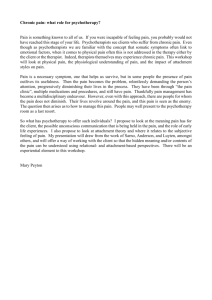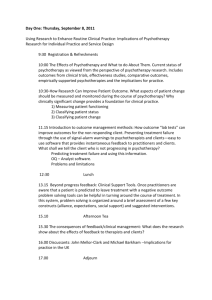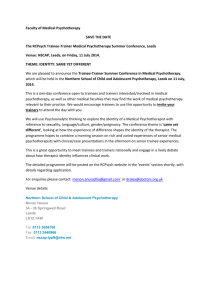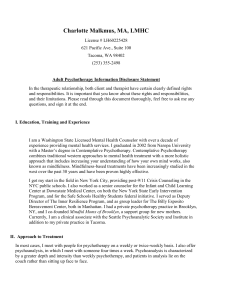Chapter 1
advertisement
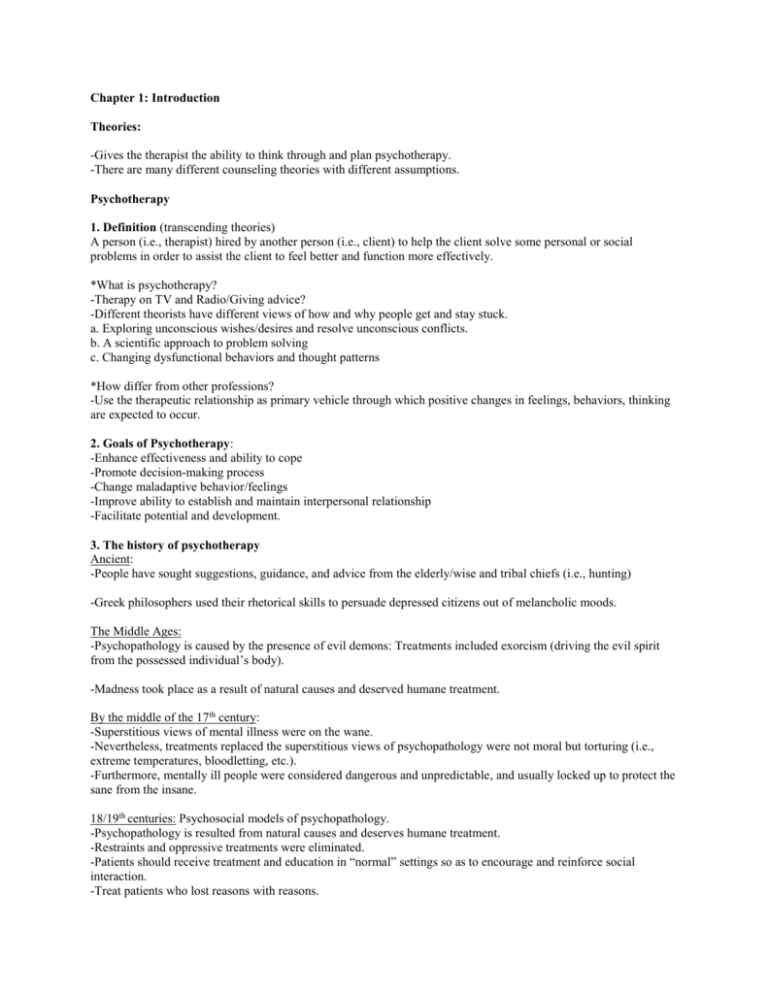
Chapter 1: Introduction Theories: -Gives the therapist the ability to think through and plan psychotherapy. -There are many different counseling theories with different assumptions. Psychotherapy 1. Definition (transcending theories) A person (i.e., therapist) hired by another person (i.e., client) to help the client solve some personal or social problems in order to assist the client to feel better and function more effectively. *What is psychotherapy? -Therapy on TV and Radio/Giving advice? -Different theorists have different views of how and why people get and stay stuck. a. Exploring unconscious wishes/desires and resolve unconscious conflicts. b. A scientific approach to problem solving c. Changing dysfunctional behaviors and thought patterns *How differ from other professions? -Use the therapeutic relationship as primary vehicle through which positive changes in feelings, behaviors, thinking are expected to occur. 2. Goals of Psychotherapy: -Enhance effectiveness and ability to cope -Promote decision-making process -Change maladaptive behavior/feelings -Improve ability to establish and maintain interpersonal relationship -Facilitate potential and development. 3. The history of psychotherapy Ancient: -People have sought suggestions, guidance, and advice from the elderly/wise and tribal chiefs (i.e., hunting) -Greek philosophers used their rhetorical skills to persuade depressed citizens out of melancholic moods. The Middle Ages: -Psychopathology is caused by the presence of evil demons: Treatments included exorcism (driving the evil spirit from the possessed individual’s body). -Madness took place as a result of natural causes and deserved humane treatment. By the middle of the 17th century: -Superstitious views of mental illness were on the wane. -Nevertheless, treatments replaced the superstitious views of psychopathology were not moral but torturing (i.e., extreme temperatures, bloodletting, etc.). -Furthermore, mentally ill people were considered dangerous and unpredictable, and usually locked up to protect the sane from the insane. 18/19th centuries: Psychosocial models of psychopathology. -Psychopathology is resulted from natural causes and deserves humane treatment. -Restraints and oppressive treatments were eliminated. -Patients should receive treatment and education in “normal” settings so as to encourage and reinforce social interaction. -Treat patients who lost reasons with reasons. 20th century: -Analytic-Dynamic psychotherapies Explore unconscious/motivational conflicts among personality structures Provide patients with insights into their unresolved conflicts, wishes, and needs. Resolve conflicts and Redirect energies toward current adaptive tasks. (EX) Classical psychoanalysis (Freud, 1963; Adler, 1956), Interpersonal theory (Sullivan, 1953), Object-relations theory (Greenberg & Mitchell, 1983), Ego-psychology (Hartman, 1964), and Self-psychology (Kohut, 1984). -Experiential-Expressive psychotherapies Psychopathology was resulted from failure to give adequate expression of concrete, non-rational, symbolic aspects of experience (i.e., emotion, feeling, bodily sensation, imagery, and imaginative fantasy) Restore and attain psychological well-being through creative self-expression, rebalancing/harmonizing of personal energies, re-attuning the flow of immediate sensory and affective experience in consciousness and behavior. (EX) Person-Centered Therapy (1951), Gestalt Therapy (Perls, 1976) -Cognitive-Behavior therapy: Maladaptive habits are caused by faulty learning and reasoning. Modify maladaptive habits by applying classical conditioning, operant conditioning, and/or social learning principles (Bandura, 1969; Goldfried & Davison, 1976, Wolpe, 1958) and by using combinations of cognitive and behavioral principles (Ellis, 1962; Beck, 1976; Kelly, 1955) -Strategic-systematic therapies Problems in the exchange and processing of information and conflict in the influence among intimates. (ex) Marriage and Family therapy. 4. Practitioners in psychotherapy: Psychiatrist (M.D.) Clinical Psychologist (Ph.D., Psy.D, MA) Counseling Psychologist (Ph.D., Ed.D, MA) School Psychologist (Ph.D., Ed.D., MA) Social Worker (DSW, MSW) Psychiatric nurse (BS, MS) 5. Managed Care: Must get permission from insurance providers regarding the number of sessions and the kind of treatment. Must also report diagnosis and some confidential information to the insurance companies. 6. Why are there so many diverse forms of therapy? -Therapist variables (i.e., theoretical orientations, age, gender, ethnicity, personalities) -Client variables (i.e., disorders, age, gender, race, intelligence, education, personalities, economic conditions) -Environmental conditions (i.e., physical settings such as hospital or universities, highly differentiated social and cultural systems). 7. Does psychotherapy work? -Eysenck (1952): Reviewed 24 studies and concluded that psychotherapy (specifically psychoanalysis) was less effective than no therapy. About 66% of neurotic patients recover or improve to a marked extent within about 2 years of the onset of their illness, whether or not they were treated by means of psychotherapy. -Stimulated others to conduct research on the efficacy of psychotherapy. -Researchers found that there were significant errors in Eysenck’s research and statistical procedures. -Many researchers (i.e., Meltzoff & Kornreich, 1970; Bergin, 1971, Smith & Glass, 1977; Luborsky et al., 1993) found that psychotherapy was effective. -For example, Smith and Glass (1977) reviewed about 400 studies and reported that psychotherapy was beneficial to clients (i.e., clients with therapy were 75% better off than untreated clients). 8. Which type of psychotherapy by whom does work best for which client in which situation? -Smith & Glass (1977) did not find the significant differences between behavioral vs. non-behavioral therapy, or even between experienced vs. non-experienced therapist. -Luborsky et al. (1993) compared group vs. individual therapy, time-limited vs. unlimited, behavior vs. psychodynamic therapy, and psychodynamic vs. client-centered therapy, and found no significant differences in terms of their effectiveness. -Garfield (1992) suggested that variables (i.e., therapist characteristics, client characteristics, disorders) affecting therapy are hard to control and evaluate in outcome studies. -There are over 400 forms of psychotherapy, about 150 classes of disorders, and about 14 different practitioners, resulting in millions of comparisons. -No single theory can account for the complexities of a given client and one’s problems (Corey, 2001). -Eclectic/integrating approach: Utilizing procedures and views from more than one theoretical orientation. 9. Good therapists? -A positive expectancy and faith in what they do (i.e., self-fulfilling prophecy). -A strong belief/trust that clients are able to change and can make choices about their changes. -Sensitivity to the attitudes and actions of others -Emotional stability and objectivity -A capacity of being trusted by others -Commitment to individual human values -A deep interest in people and patience with them -Open-mindedness -Good assessment (what problems and why and how they get into their problems) and treatment plan (what kinds and directions of changes facilitate and support). -Try to learn, grow, and improve therapeutic skills. 10. Despite the presence of many and varied competing approaches, this class will focus on the similarities of the approaches to psychotherapy than to focus on their differences. *Common factors (Hubble, Duncan, and Miller, 1999) -Experiencing a “clustering of good things such as a new job, supportive family, promotion, etc.” in life while in therapy (40%) -Working relationship (i.e., the therapist-client relationship in terms of warmth, caring, empathy, acceptance, mutual affirmation, and encouragement can be instrumental in success) (30%) -Expectancy or placebo effects (i.e., “client’s belief that she or he will get better because of therapy”) (15%) -Specific intervention or technique (15%) 12. A model of stages of change (Prochaska and Norcros, 2003) 1. Precomtemplation (i.e., denial of problems) 2. Comtemplation (i.e., acknowledge that they have a problem, but do nothing about it) 3. Preparation (making small steps toward change but are not really making a serious attempt to change their behavior) 4. Action (i.e., committing time and energy making progress toward their goals) 5. Maintenance (i.e., not falling back) 13. Problems about managed care: Brief and short sessions.



![UW2 - Psychiatric Treatments [2014]](http://s3.studylib.net/store/data/006859622_1-db6167287f6c6867e59a56494e37a7e7-300x300.png)

